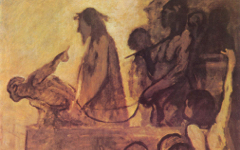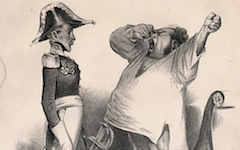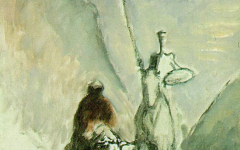Daumier’s The Orchestra.. ..During A Tragedy (1852)
For most people Honoré Daumier was a skilled draughtsman and keen observer of Parisian life. And even though he painted a few canvasses, his reputation rests primarily on his graphic output, mostly caricatures published in popular newspapers. Many critics call such work "low art" (mass reproduction) to distinguish it from "high art" (unique canvasses). I don't believe either term has validity. Art is art wherever you find it. Edgar Degas owned six of Daumier's paintings and drawings and an astounding 1,800 of his lithographs. He must have been drawn, I believe, to the older master's hidden meaning which few except Degas can have ever recognized.

Daumier, The Orchestra During the Performance of a Tragedy (1852) Lithograph on paper. Metropolitan Museum of Art, New York.
Click image to enlarge.
Superficially Daumier's print makes fun of classical tragedies, like the one on stage. But underneath, for those who can see, Daumier drew something else entirely. The musicians by their music stands resemble artists by their easels. The sheet music is their initial "sketch". Three performers are asleep, deep in imagination.
Up above actors in ancient costumes, drawn differently from the orchestra, more line than shade, resemble classical sculptures and, thus, works of art. The two styles differentiate between the "studio" below and the "finished work" above. The dark orchestra pit represents the artist's mind; the stage-lit figures are its product. The extended hand on stage, a gesture of speech, esoterically symbolizes art's craft in the center of the image because Daumier draws himself.
Click next thumbnail to continue
The principal musician yawns. He turns his head towards his shoulder as painters do in their self-portraits because they generally look in the mirror while working on their easel to one side. That's why this man's mouth is D-shaped for Daumier.
Click next thumbnail to continue
Chairs, occupied or not, often symbolize the artist who so often sits to paint or draw. A chair in a lower corner where signatures go are even more likely to mean that. This one (far left) forms the top part of an H for Henri (lower left) while forming a second D (lower right). This is very similar to how Henri Matisse included his initial in a chair in his 1911 painting, Red Studio. Neither has ever been "seen". Nor the several dozen more examples under the theme Letters in Art.
Click next thumbnail to continue
Daumier also turned the kettle-drum into three symbols and signed it with his initials. A symbol of sound, it conveys vision as a circular "eye". The padded head of its stick is a "pupil" (an open "eye") but the stick itself suggests a closed eye, like the slightly curved line between two eyelids. Fully aware of how important open and closed eyes are in art, Daumier conveys both forms of visual perception, insight and out-sight, in one "eye".
On still another level, the drumstick represents a "paintbrush" resting on the drumskin-"palette" thereby making the skin a "piece of paper" as well (which it is). "Brevity", Shakespeare wrote, "is the soul of wit."

Degas, The Orchestra of the Opera (1868-9) Oil on canvas. Musée d'Orsay, Paris
Click image to enlarge.
Daumier's composition is packed with poetic content. Music, for instance, has its own theme on EPPH because it is an age-old but little-known metaphor for the creation of visual art. Art on Stage has its own theme too. The caricaturist was clearly well versed in the wisdom-tradition of art which, if you know what to look for as Degas did, you can probably find in any of those 1,800 prints by Daumier he owned. Theodore Reff says that Degas based his Orchestra of the Opera (left) on Daumier's print. Unnoticed, though, is that the back of the chair which Degas also signed is "framed" and in the same vertical format as the painting itself. Above the musicians ballerinas dance. They look just like.....a painting by Degas.
More Works by Daumier
One of the easiest ways to find unseen features in paintings is to look for the artist's initials. Daumier included them more than most.

Daumier’s Ecce Homo (c.1849-52)
Notes:
1. Theodore Reff, Degas: The Artist's Mind (New York: Metropolitan Museum of Art) 1976, pp. 77-8
Original Publication Date on EPPH: 20 Sep 2013. © Simon Abrahams. Articles on this site are the copyright of Simon Abrahams. To use copyrighted material in print or other media for purposes beyond 'fair use', you must obtain permission from the copyright owner. Websites may link to this page without permission (please do) but may not reproduce the material on their own site without crediting Simon Abrahams and EPPH.





